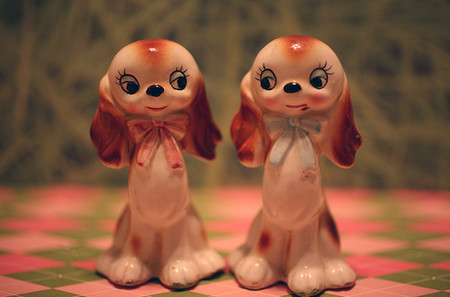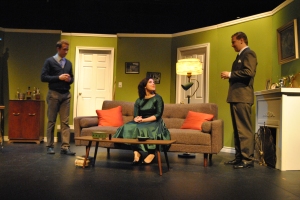1. A Mini History Lesson:
Radical Dishtowels

ABOUT: “As a family, we’ve always been interested in the amazing stories of history’s radical thinkers and campaigners, and how much hope these stories can inspire relative to the politics of today. We didn’t have much business experience. But we realized that there must be other people with progressive values out there who wanted to give gifts that actually mean something, make you think, and give you hope. We all loved the idea that you might come across a design in someone’s kitchen, and that it would spark a conversation about an idea or philosophy. As a teacher, I imagined that children might see a design and ask, “Who was she?” Together we made the decision to start our very own Radical Tea Towel Company. We do all the designs ourselves, and get them manufactured in the UK with ethical partners.” Read the full story, here.
PRICE RANGE: $
SOCIAL IMPACT: Made ethically in the UK, the main impact is in the message on the towel. What a fun way to strike up a conversation about something important, even controversial.
WHAT WE LIKE: This is such a unique idea. I’ve seen some cool tea towels, but never anything like this. They cost a bit more than the average tea towel, but are still inexpensive enough I could justify buying it if I had a place to have it visibly hanging in my kitchen.
2. Placemats and Doormats Inspired by Vintage Tiles:
Hidraulik

ABOUT: “The first hydraulic tiles were produced in Barcelona in the mid nineteenth century. The creativity and durability of these attractive yet functional handmade floors caught on quickly and their use spread across Europe and beyond.”
The brand is carried by Locus Vie, a distribution company for home decor products in North America. They focus on small European design companies that are looking to make an entrance into the North American market, and you can find local retailers via their site.
PRICE RANGE: $$-$$$
SOCIAL IMPACT: The site says that they are “phthalate-free and recyclable, for an eco-friendly conscience”. While made in Spain, there are many local shops, usually small ones, that carry some of these designs.
WHAT WE LIKE: They have a vintage vibe but are super practical. They make great door mats or a runner for a high-traffic hallway, they are easy to clean and can cover up ugly rental flooring. They are a bit on the pricey side for the larger ones (I saved up and watched for sales for years before I finally got one), but a set of the placemats could make a lovely gift, and they work well inside or out!
3. Textiles Based on Traditional Indigenous Designs
Indigo Arrows

ABOUT: “For thousands of years, Indigenous peoples in Manitoba, including my Anishinaabe ancestors, created beautiful patterns to adorn their pottery collections and host of bone tools. Most of the surviving pieces are held by museums now, but I think the world needs more than exhibition- we need these patterns in our homes provoking thought; we need them bridging gaps; and, we need them inspiring our loved ones. The Indigo Arrows line picks up where my ancestors left off.
Destiny Seymour is an Anishinaabe interior designer based in Winnipeg, Manitoba. She graduated with her master’s degree in Interior Design from the Faculty of Architecture at the University of Manitoba. She worked at local architecture firm in Winnipeg for over 10 years as their interior designer before starting her own design business in 2016.
Destiny started designing artisan textiles for interiors that respectfully reflects local Manitoban Indigenous peoples and their history after struggling to find materials that she could incorporate into design projects. Her company, Indigo Arrows, now offers a range of table linens, pillows, and blankets that showcase patterns from local Indigenous pottery and bone tools that date from 400 to over 3000 years old. These patterns are picking up where her ancestors left off.
Destiny formed Woven Collaborative in 2018, an Indigenous led design studio with fellow designer Mamie Griffith. Their design practice takes a critical look at the representation of Indigenous cultures within spaces. Their design mission is to respectfully reflect local Indigenous cultures & identity within architectural forms, interior spaces, furniture, and textiles. Their design process acknowledges community engagement, inclusiveness, and collaboration when creating new works.”
PRICE RANGE: $-$$
SOCIAL IMPACT: These beautiful linens are handmade, individually hand-printed in Winnipeg, Manitoba on 100% linen using non-toxic ink. This Indigenous-run company is making something that is simultaneously modern and traditional: these designs look like something you’d find in a magazine today while many of them are actually thousands of years old. Destiny names them in her ancestral language, Anishinaabemowin, and the pieces have a little description of what the word means and its significance, so it’s a nice little learning moment as well.
WHAT WE LIKE: If I had seen these without the context I would have thought they were totally modern, but when I read the history I knew they were perfect for this post: vintage-inspired doesn’t have to mean “old looking”, and it doesn’t have to be a perfect reproduction of something either. It also made me realize that a lot of the modern “boho” things you see in chain stores have (whether intentionally or not) designs that were used historically in Indigenous art, and so why not support the maker who shares that history? Promote the use and creation of something that comes from generations of artisans rather than buy a knock-off mass produced in China? And honestly, while some fellow artists may not have the money for a $100 decorative pillow, I think we all know that given the work that goes into it, that’s a steal. A lot of these are less expensive than things you’d find at Crate & Barrel or West Elm, and you can shop guilt-free knowing you’re supporting the artist who made them, not some faceless corporation.
4. Retro Canadian Pillows:
Persnickety Designs

ABOUT: Peggy McEwan is a Toronto-based artist with a background in classic animation. These pillows are what she calls “comfortable art”, and they come in a range of retro designs – Toronto landmarks, old movie stars, vintage maps – there’s something for everyone.
PRICE RANGE: $-$$
SOCIAL IMPACT: You’ll be supporting a local female artist!
WHAT WE LIKE: I’ve been eyeing several of these for years, but found they were usually a little out of my price range. However, that was when I came across them in stores – I just realized you can buy from her site at about half of what I’d always seen them for before, and I may have to redo all my cushions! I love pop art but you don’t find a lot of it locally made, so I’m happy to add these to my already massive pillow collection.
5. True Vintage Serving-ware
Ethel 20th Century Living

ABOUT: “Ethel – 20th Century Living is a vintage furniture, lighting and accessories store in the East Danforth neighbourhood in Toronto.
After helping to establish “Retro Row” in Leslieville 20 years ago, Ethel was starting to show her age. After the store changed ownersip in October 2009, it conducted business in the original location for 3 more years, and in May 2012, Ethel moved to Corktown. In the fall of 2016, we decided to close our bricks and mortar location at 327 Queen St. East, and now, two years later, we have a new home at 1781 Danforth Ave.
Owner Shauntelle LeBlanc has re-established Ethel’s brand as a store for outstanding vintage modern furniture, lighting & accessories. The store’s focus is on affordable vintage because you should enjoy your furniture, feel free to put your feet up on it and certainly not feel like you’re living in a museum (or magazine spread…unless that’s your thing, and in that case, Ethel is cool with that too).
We’re a proud Canadian indie boutique, and along with classic American & Scandinavian design, you’ll also find Canadian Mid-century pieces here. Sure, we all love Eames, Nelson & Knoll, but have you heard of Russell Spanner, Lotte Lamps or Clairtone?
Vintage is nearly always one of a kind so our merchandise is constantly changing. You might find a complete Brady Bunch kitchen in here, or maybe a film noir detective movie set, complete with tanker desks & typewriters. Ethel has a little bit everything, from gondola sofas and teak dining sets to oddball pieces like 80s Russian propaganda posters and vintage tiki mugs.
Along with 20th century furniture, lighting and accessories, we also carry new products by RetroVerte, Umlaut Brooklyn, and more.”
PRICE RANGE: $-$$$
SOCIAL IMPACT: A local, female-run boutique selling vintage – sustainable in many ways.
WHAT WE LIKE: There are MANY vintage shops in the city (though sadly, not as many as there once were) and I have my favourites for various things. Ethel’s is where I go for mid century. You can rely on finding a lamp, vase, serving piece etc. from the 50s-60s there, likely in whatever colour you’re looking for. She often has a selection of small retro furniture as well, like card tables and chairs.
Have something you think should be on our list?
Let us know in the comments.

























